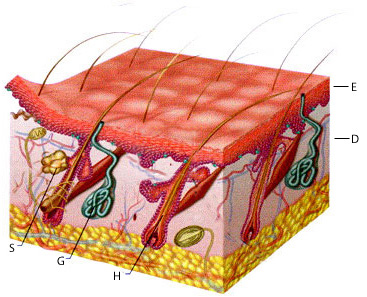

Sweat is essential to human survival and serves as the body’s coolant, protecting it from overheating.
There are two to four million sweat glands distributed all over our bodies. The majority of them are “eccrine” sweat glands, which are found in large numbers on the soles of the feet, the palms, the forehead and cheeks, and in the armpits.
Eccrine glands secrete an odorless, clear fluid that helps the body to control its temperature by promoting heat loss through evaporation. In general, the type of sweat involved in hyperhidrosis is eccrine sweat.
The other type of sweat gland is called an “apocrine” gland. Apocrine glands are found in the armpits and genital region. They produce a thick fluid. When this fluid comes in contact with bacteria on the skin’s surface, it produces a characteristic potent "body odor".
Both the eccrine and apocrine sweat glands are activated by nerves. These nerves respond to a variety of stimuli including:
• messages from the brain indicating that the body is too hot
• hormones
• emotions
• physical activity or exercise
In people who have excessive sweating or hyperhidrosis, the sweat glands (eccrine glands in particular) overreact to stimuli and are just generally overactive, producing more sweat than is necessary. It's often said that people with hyperhidrosis have sweat glands that are stuck in the "on" position. (Ready to learn more about hyperhidrosis? Listen to the Hyperhidrosis 101 podcast now.)
Contrary to a popular myth on the internet, sweat is NOT made up of toxins and therefore you don't 'sweat out' toxins. Rather, sweat is made up of 99 percent water and small bits of carbs, salt, protein, and urea. The kidneys and liver are the organs responsible for detoxing your body (not the sweat glands).
of 99 percent water and small bits of carbs, salt, protein, and urea. The kidneys and liver are the organs responsible for detoxing your body (not the sweat glands).
Not all excessive sweating is the same. And, in fact, sometimes profuse sweating can be a sign of something very serious. Learn more about the two types of hyperhidrosis here. Whether you have primary focal hyperhidrosis or generalized secondary hyperhidrosis, we have incredible resources for you here at the International Hyperhidrosis Society and we hope you'll explore this website thoroughly. As you do so, you'll even find important info about sweat issues you've probably never heard of before, including not sweating at all, colored sweat, bloody sweat, smelly sweat.
Illustration explanation: The skin is composed of an epidermal layer (E) from which hair follicles (H), sweat glands (G), and sebaceous glands (S) descend into the underlying dermis (D). Attribution: Reprinted from Robbin’s Pathologic Basis of Disease, Edition 6, Cotran, Ramzi S., Chapter 27, Fig 27-1A, Copyright 1999, with permission from Elsevier.
Latest Blogs